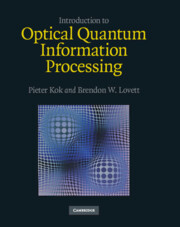Book contents
- Frontmatter
- Dedication
- Contents
- Preface
- Part I Quantum optics and quantum information
- Part II Quantum information in photons and atoms
- Part III Quantum information in many-body systems
- 8 Quantum communication with continuous variables
- 9 Quantum computation with continuous variables
- 10 Atomic ensembles in quantum information processing
- 11 Solid-state quantum information carriers
- 12 Decoherence of solid-state qubits
- 13 Quantum metrology
- Appendix A Baker–Campbell–Haussdorff relations
- Appendix B The Knill–Laflamme–Milburn protocol
- Appendix C Cross–Kerr nonlinearities for single photons
- References
- Index
12 - Decoherence of solid-state qubits
from Part III - Quantum information in many-body systems
Published online by Cambridge University Press: 05 July 2014
- Frontmatter
- Dedication
- Contents
- Preface
- Part I Quantum optics and quantum information
- Part II Quantum information in photons and atoms
- Part III Quantum information in many-body systems
- 8 Quantum communication with continuous variables
- 9 Quantum computation with continuous variables
- 10 Atomic ensembles in quantum information processing
- 11 Solid-state quantum information carriers
- 12 Decoherence of solid-state qubits
- 13 Quantum metrology
- Appendix A Baker–Campbell–Haussdorff relations
- Appendix B The Knill–Laflamme–Milburn protocol
- Appendix C Cross–Kerr nonlinearities for single photons
- References
- Index
Summary
Solid-state systems, by their very nature, have a vast number of different possible quantum degrees of freedom. In Chapter 11, we saw that some of these degrees of freedom make good qubits. However, there are plenty more which are less suitable, since they cannot easily be localized and externally controlled. Once the qubit has been chosen, it is important to think about how it interacts with the other, uncontrolled quantum excitations in its environment. Such an interaction leads to unpredictable behaviour and can cause decoherence – the irretrievable loss of quantum information from the qubit – and this will be the topic of this chapter. The most obvious decoherence mechanism for any optical manipulation scheme is the spontaneous emission of photons. The theory behind this follows analogously from the theory we discussed in Chapter 7, with a suitable definition of a transition dipole for the relevant transitions. However, solid-state systems bring with them lattice vibrations, or phonons, which have no direct atomic analogue. We will therefore focus on phonons in this chapter, first discussing how we model them, and second how they interact with the electron-based qubit that we discussed in the last chapter. Later, we will see how this leads to a loss of coherence, and how optical methods can be used to slow the rate of coherence loss. Phonon interactions are complex and not easy to model exactly, but we will show that with certain approximations very successful theories can be developed.
- Type
- Chapter
- Information
- Introduction to Optical Quantum Information Processing , pp. 397 - 420Publisher: Cambridge University PressPrint publication year: 2010



